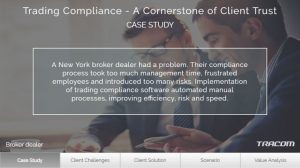The majority of B2B marketing organizations are measured on achieving the company’s revenue targets assigned to sales. However, a significant gap still exists between sales presentation content produced by marketing and the content expected by sales. Sirius Decisions reports that 65% of content created by marketing for sellers never gets used. Marketing costs for creating content continue increasing to record levels, yet, sales’ requests for better customer-centric content for critical buyer meetings are rampant. What are the communication issues between marketers and sales teams?
Ironically, the major issue is NOT the quality of content. Sirius Decisions found that the main reasons why content goes unused are topic relevancy (to buyer), users are unaware content exists, content is difficult to find, and it’s too time consuming to adapt for customer meetings. Rather than diving into negative aspects of this expensive and unproductive dilemma, let’s review what successful marketing teams know and are doing to provide unique presentations for customer-facing sales teams to achieve revenue targets by winning more competitive opportunities.
Top marketing teams know these three “game changing” impacts in today’s Digital Age have created new challenges in developing introductory sales presentations and marketing content:
- Buyers perform extensive web research and explore social media BEFORE engaging sellers. Sales is facing more prepared buyers. During initial sales meetings, buyers expect sales reps to be knowledgeable about their industry, present business insights on how their offering has helped similar companies, and show typical quantified business results achieved by their most successful customers.
- Sellers must avoid the traditional “data discovery” set of questions EARLY in the sales process. Buyers will disengage quickly with sales teams asking for confidential data early in the evaluation process before earning this privilege. Customers expect collaborative business conversations with sellers confirming their understanding of the customer’s business problems before it’s determined a qualified fit for both companies to pursue.
- Presentations created by marketing must be in a SALES-READY format. Almost 50% of a sales rep’s time is wasted looking for the right content to present to the right customer at the right time in the sales process. Sales reps do not have time to search, evaluate, adapt and create personalized content for early sales presentations, so in most cases they defer to the standard Corporate Overview and hope for the best. Costly Digital Asset Management repositories are making the problem worse, not better, for sales reps as evidenced by low adoption rates.
What do sales teams expect of marketing for early stage sales presentations?
Top performing marketing teams focus on creating relevant, engaging sales presentations resulting in more qualified sales opportunities. Suzy Welch, Author and Business Journalist, states, “Half the battle in business is being prepared.” Successful marketing-developed sales presentations help sales reps exude confidence in customer meetings, because they trust the content is customer-centric, includes unique customer messaging, and is differentiated versus competition! Sales reps do not want new content as much as they need existing content based on successful customer stories packaged in a sales-ready format. Every B2B website has a Case Study with all the information sales teams need to qualify early opportunities. However, individual case studies may be too specific for an early sales meeting, and definitely are not in a presentation format to maximize customer engagement. Sending multiple PDF case studies to customers via email expecting them to be read, understand and accelerate interest is a recipe for disaster. Digitally savvy marketing professionals know there’s a better way to communicate with customers in today’s Digital Transformation Age instead of emailing content to a busy customer’s inbox.
Digital Value Propositions transform your case study into a powerful sales tool.
Here are three best practices highly effective marketing teams follow to create Digital Value Propositions based on a consensus of information, data and results from your most satisfied customers:
- START WITH A CUSTOMER PROBLEM STATEMENT: Too many sales presentations present product or service features & benefits only, and fail to address the real problem statement directly at the beginning of the meeting. An introduction slide or two about your company is fine; however, within five minutes your presentation should succinctly address a typical customer’s business problem and how your solution solves their problem. Research from senior B2B buyers clearly shows sellers must be prepared to answer this question early, “What do you do for your customers?”

- SHOW TYPICAL CUSTOMER CHALLENGES AND RESULTS: Share with the audience typical challenges faced by your customers including average quantitative business results achieved. Recommend three typical qualitative results (reduce costs, increase revenue, avoid risk), and typical quantitative results achieved (reduced costs by 20%, increased revenue by $500 Million, etc.). Avoid using exact data during initial sales meetings as the customer opportunity has not been qualified at this stage. Customers usually ask initial questions at this point which are positive signs of interest. If there are no questions, you’ve the right to ask, “Does your company have any of these concerns?”

- CREATE A CUSTOMER VISION FOR SUCCESS: A simple Value Proposition will show financial results your successful customers have achieved using your solution. At this stage of the presentation when showing these results, expect engaged buyers to ask questions primarily related to the “business assumptions” used to determine these results. A good marketing developed Digital Value Proposition includes base assumptions (total employees, volume of transactions etc.), AND a built-in interactive calculator capability to change data assumptions using some specific data volunteered by the customer (i.e. change 10,000 employees to 15,500 employees) that instantly displays revised financial results. Your audience will be impressed. Forrester Research shows the first seller to create a vision to value wins the business 74% of the time.

Summary
Most good sales opportunities from MQLs are LOST in early customer meetings by field and inside sales teams that do not present the customer value of your offerings. Best-in-class marketing teams create Digital Value Proposition sales presentations that are easy to find by reps, fit the specific solution for their meeting in the customer’s industry, and are “sales-ready”. Sales will experience faster engagement and collaboration from buyers by proactively presenting typical case study business drivers and results achieved by your typical customers.
CMOs know the key metrics in today’s sales and marketing funnel has moved rapidly from MQLs (Marketing Qualified Leads) to SQLs/SQOs (Sales Qualified Leads/Opportunities) to achieve revenue targets. Sales teams using Digital Value Propositions from marketing are experiencing 10-15% increase in qualified sales opportunities leading to 20-30% increase in winning deals. That’s why sales teams are applauding their marketing teams in the Digital Age for developing customer-centric sales presentations including your Value Proposition!
Watch Now!
2-min Video on the benefits of a Digital Value Proposition

